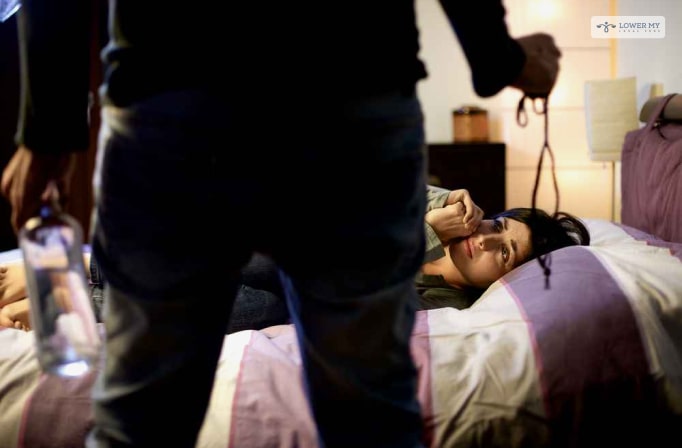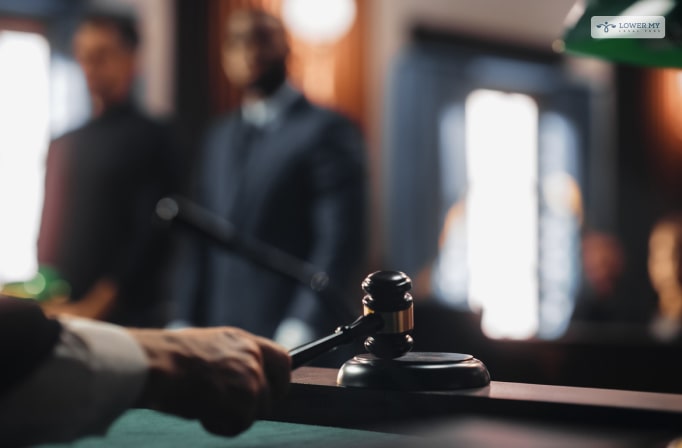When a criminal act occurs, it’s obvious that it will go to the trial process;
Moreover, the trial occurs to provide the opportunity for both the defendant and the prosecution to showcase their side of the story to acquire the legal remedy.
But are you aware of the fact of what happens when a case goes to trial in court? In this article, we will be discussing the point about what happens when a case goes to trial.
What Happens When A Case Goes To Trial?

Going to trial can be a dramatic and intense experience, often depicted in movies and TV shows with courtroom showdowns and gripping testimonies.
Moreover, But what really happens when a case goes to trial? To prepare for a trial, it’s also important to know the difference between a hearing vs trial.
Here’s what you should know.
1. Preparation for Battle:
Before the trial even begins, both sides, the prosecution and the defense, gear up for a legal showdown.
Moreover, This involves collecting evidence, identifying witnesses, and crafting legal arguments. Think of it as the calm before the storm.
2. Jury Selection:
If it’s a jury trial (not all trials have juries), the court selects potential jurors through a process called “voir dire.”
Moreover, Lawyers from both sides ask questions to ensure impartiality. It’s like assembling the cast for a legal drama.
3. Opening Statements:
Picture this as the movie trailer. Lawyers on both sides present their version of the story to the jury.
Moreover, It’s their chance to set the stage and outline what they plan to prove.
4. Witnesses Take the Stand:
Here comes the star-studded lineup! Witnesses, including experts, testify under oath.
Moreover, They’re questioned by both sides, aiming to support their side’s arguments and discredit the other side.
5. Cross-Examination:
This is where things get spicy.
Moreover, Lawyers try to poke holes in witnesses’ stories. It’s like a high-stakes game of “gotcha!” between the attorneys.
6. Exhibits and Evidence:
Documents, photos, and physical evidence (the murder weapon, perhaps?) are introduced. It’s like the puzzle pieces that complete the picture.
7. Closing Arguments:
Lawyers make their final pitches to the jury.
Moreover, This is their last chance to convince the jury to see things their way.
8. Jury Deliberation:
The jury retreats to a room to hash it out. It’s like a mini-movie where they debate, discuss, and, hopefully, reach a unanimous decision.
9. Verdict Time:
The big moment arrives!
Moreover, The jury announces whether the defendant is guilty or not guilty. Cue the gasps, tears, or sighs of relief.
10. Sentencing (if applicable):
If the verdict is guilty, the judge determines the punishment. It’s like the epilogue that wraps up the story.
And there you have it! The journey of a case going to trial, from the pre-game prep to the final verdict.
Moreover, Trials can be long and grueling, but they’re a crucial part of the justice system, ensuring that disputes are resolved fairly and justly.
So, next time you watch a courtroom drama, you’ll have a better understanding of what’s really happening in that legal battle.
What Happens When A Domestic Violence Case Goes To Trial?

Domestic violence cases are some of the most emotionally charged and sensitive legal matters.
Moreover, When they go to trial, it’s like watching a real-life legal drama unfold. Let’s delve into the process, breaking it down step by step.
1. Charges and Arrest:
It all starts with someone reporting domestic violence, leading to an arrest if law enforcement believes there’s enough evidence.
Moreover, The accused is then charged with a crime.
2. Arraignment:
This is the formal introduction to the legal process.
Moreover, The accused appears in court, hears the charges, and enters a plea, often “guilty” or “not guilty.”
3. No-Contact Orders:
Typically, the court issues a no-contact order to protect the alleged victim. This means no communication or physical proximity until further notice.
Moreover, It’s like a legal barrier to ensure safety.
4. Pretrial Hearings:
Lawyers from both sides meet with the judge to discuss evidence, witnesses, and any potential plea deals.
Moreover, It’s a bit like strategizing before the big game.
5. Jury Selection:
If it’s a jury trial, both sides pick jurors who can be impartial.
Moreover, This is especially crucial in domestic violence cases, given their emotional nature.
6. Opening Statements:
Lawyers give a sneak peek of their case, like movie trailers.
Moreover, They introduce their arguments and what they aim to prove.
7. Witnesses and Evidence:
The alleged victim, law enforcement officers, and any eyewitnesses testify.
Moreover, Physical evidence, such as photos of injuries or 911 call recordings, can be presented.
8. Cross-examination:
This is where lawyers dig deep. They question witnesses to challenge their credibility or the accuracy of their statements.
9. Closing Arguments:
Lawyers make their final pitch to the jury, summing up the evidence and arguments and explaining why their side should win.
10. Jury Deliberation:
The jury goes behind closed doors, just like in the movies, to discuss and reach a verdict. It’s a crucial moment as they weigh the evidence and testimonies.
11. Verdict:
The courtroom holds its breath as the jury delivers its decision. Guilty or not guilty, this is the climax of the legal drama.
12. Sentencing:
If the verdict is guilty, the judge determines the punishment, which can include fines, probation, counseling, or even jail time.
13. Protection Orders:
The court may issue long-term protection orders to ensure the safety of the victim even after the trial ends.
In domestic violence cases, emotions run high, and the stakes are deeply personal. Moreover, The legal process aims to balance justice and protection, holding those responsible accountable while safeguarding victims.
So, when a domestic violence case goes to trial, it’s not just about the law; it’s about healing and preventing future harm.
What Happens When A Divorce Case Goes To Trial?

Divorce, often an emotionally charged journey, can sometimes lead couples to the courtroom when negotiations fail.
Moreover, When that happens, it’s like watching a legal rollercoaster.
Let’s explore what occurs in a divorce case that goes to trial.
1. Petition for Divorce:
The journey begins with one spouse filing a divorce petition. It’s like the opening act in this legal drama.
2. Response and Counterclaim:
The other spouse responds to the petition, potentially with a counterclaim, stating their terms for the divorce.
Moreover, It’s akin to the plot thickening.
3. Temporary Orders:
The court may issue temporary orders regarding child custody, spousal support, and other immediate matters while the case is pending.
Moreover, Think of this as a temporary script until the final act.
4. Discovery:
Both sides gather information, documents, and evidence. It’s like detectives collecting clues to build their case.
5. Negotiation:
Before going to trial, couples often engage in settlement talks, either privately or through mediation. It’s like trying to write a compromising script.
6. Pretrial Conference:
The court may schedule a pretrial conference to encourage settlements or streamline issues for trial, much like a script rehearsal.
7. Trial Preparation:
Lawyers prepare their strategies, identify witnesses, and ensure all evidence is ready. It’s akin to the cast and crew getting ready for a big performance.
8. Jury or Judge:
Depending on the case, it may be decided by a judge or a jury, like choosing the audience for a theatrical performance.
9. Opening Statements:
Lawyers set the stage, explaining their client’s perspective and what they aim to prove. It’s the prologue to the courtroom drama.
10. Witness Testimony:
Witnesses, including the couple and experts, take the stand. They provide their versions of events, sometimes tearfully, like actors in a courtroom play.
11. Cross-Examination:
Lawyers cross swords, challenging witnesses’s credibility and the facts presented. It’s like a courtroom duel.
12. Exhibits and Evidence:
Documents, financial records, and other evidence are introduced.
Similarly, much like props in a theatrical production.
13. Closing Arguments:
Lawyers make their final pitch to the judge or jury, summarizing their case and urging a particular outcome, just like the climax of a story.
14. Verdict:
Similarly, The moment of truth arrives as the judge or jury delivers their decision, signaling the end of this legal drama.
15. Final Orders:
The court issues the final divorce decree, outlining the terms of the divorce, property division, child custody, and support.
Similarly, While a divorce trial can be emotionally draining, it’s the legal forum for resolving complex issues when negotiations falter.
Moreover, It’s a legal performance with high stakes, where the judge or jury has the final say on how the script ends.
Frequently Asked Questions (FAQs)
Here are some of the frequently asked questions related to the process of a case going to trial:
A trial is a formal legal proceeding in which a case is presented before a judge or jury. It happens when parties involved in a dispute cannot reach a resolution through negotiations or settlements. It’s like a showdown in court to resolve conflicts.
Before the trial kicks off, both sides prepare intensely. They gather evidence, identify witnesses, and craft legal arguments.
Similarly, It’s like getting all the props, actors, and scripts ready for a big show.
Jurors are usually selected through a process called “voir dire,” where lawyers from both sides ask questions to ensure impartiality.
Similarly, It’s like casting the jury for the ultimate courtroom drama.
Final Thoughts
So, there you have it, the ins and outs of the trial process, demystified and laid out like scenes in a captivating drama.
Moreover, Trials are a unique blend of legal strategy, compelling storytelling, and intense emotion, making them a crucial part of the justice system.
Similarly, While they may not always have the glamour of courtroom dramas on TV, real trials are about resolving disputes, seeking justice, and ensuring that the law is upheld.
Moreover, They are a forum where evidence is presented, stories are told, and decisions are made that can impact lives.
Next time you hear about a trial, whether it’s a high-profile case on the news or a friend’s legal battle,
Moreover, you’ll have a better understanding of what’s happening behind the scenes.
Moreover, It’s like peeling back the curtain on a captivating performance, revealing the intricate choreography of the legal world.
Trials, like any great drama, can be unpredictable filled with twists and turns.
Similarly, armed with this knowledge, you can follow the legal narrative, appreciate the strategies of the lawyers, and, ultimately,
Moreover, understand how the justice system seeks to balance rights, responsibilities, and the pursuit of truth.
So, if you ever find yourself in a legal drama of your own, remember that while it can be stressful and emotionally charged,
Moreover, it’s also an opportunity for your story to be heard, your evidence to be seen, and, hopefully, for justice to be served in the end.
Read Also:






